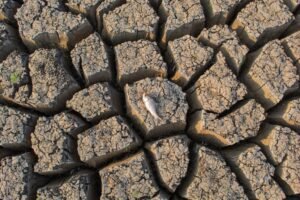
Why east flowing rivers in news?
- India’s water woes are deepening, with a new cause for concern emerging – the drying up of east flowing rivers.
- A recent analysis by the Central Water Commission (CWC) paints a grim picture: at least 13 east-flowing rivers between Mahanadi and Pennar have completely dried up.
The Devastating Impact
- These once life-giving waterways, flowing through Andhra Pradesh, Telangana, and Odisha, now lie empty, a stark reminder of the water crisis gripping the region.
- The impact is far-reaching, affecting agriculture, livelihoods, and the very fabric of life in these areas.
- The drying up extends beyond these 13 rivers.
- The Cauvery, Pennar, and other east-flowing rivers further south are facing severe water scarcity.
- Even the mighty Ganga, the country’s largest river basin, has recorded storage levels at less than half its capacity.
- This situation is not new; India’s 150 major reservoirs are currently at a worrying 36% capacity, with several completely devoid of water.
A Perfect Storm: Causes of the Crisis
- Deforestation and Soil Erosion: The relentless destruction of forests along riverbanks and catchment areas has severely compromised the land’s ability to retain water. This leads to reduced groundwater recharge and ultimately, diminished river flows.
- Climate Change: Erratic weather patterns, including irregular rainfall and rising temperatures, are disrupting river flows. Prolonged droughts, a hallmark of climate change, are further exacerbating the problem.
- Dams and Water Diversion: The construction of dams and diversion of water for irrigation purposes has significantly reduced downstream flow, disrupting the natural flow patterns and ecosystems of rivers.
- Water Pollution: Industrial effluents, agricultural runoff, and domestic waste contaminate river water, harming aquatic life and degrading overall river health. Invasive species like water hyacinths further compound the issue.
- Sand Mining: Unchecked sand mining along riverbeds disrupts natural flow and causes erosion, leading to the drying up of stretches.
- Urbanization and Encroachment: Urban sprawl and encroachment on riverbanks have altered natural flow patterns and reduced the availability of water for the river itself.
A Call to Action: Solutions for a Sustainable Future
- The situation demands immediate and decisive action. Here are some potential solutions.
- Water Conservation Measures: Implementing water conservation techniques like rainwater harvesting, watershed management, and soil moisture conservation can help replenish groundwater and reduce reliance on surface water.
- Efficient Irrigation Practices: Encouraging farmers to adopt drip and sprinkler irrigation can significantly reduce water wastage and ensure sustainable water use in agriculture.
- Afforestation and Vegetative Cover: Increasing forest cover through afforestation and reforestation efforts is crucial. Vegetation helps maintain river flow by reducing soil erosion and promoting groundwater recharge.
- Regulation of Groundwater Extraction: Stricter regulations on groundwater extraction can help maintain base flow in rivers and prevent their drying up.
- Interlinking of Rivers: Exploring the feasibility of interlinking rivers to transfer surplus water from water-rich regions to water-deficient regions can be a potential solution. The Ken-Betwa River linking project is an example of such an initiative.
- Community Participation: Engaging local communities in water management and conservation efforts is essential for ensuring sustainable water use and maintaining river flow.
- Policy Reforms: Policy reforms promoting sustainable water management practices and regulating water use are crucial to combat river drying.
- Research and Development: Investing in research and development of new technologies and practices for water conservation and management can lead to innovative solutions.
Conclusion
- While water storage levels in some basins might be reported as “normal” compared to past years, the crisis unfolding in specific regions cannot be ignored.
- The drying of east flowing rivers serves as a stark warning.
- We must act now to mitigate the impact of these droughts and safeguard the well-being of affected communities.
- The future of our rivers depends on our collective efforts.
- By implementing these solutions and fostering a culture of water conservation, we can ensure that these vital lifelines continue to flow for generations to come.
People also ask
Q1: What’s happening with the rivers?
Ans: A worrying trend is unfolding – at least 13 east flowing rivers in India, between Mahanadi and Pennar, have completely dried up. This is causing a water crisis in states like Andhra Pradesh, Telangana, and Odisha.
Q2: What’s happening with India’s east flowing rivers?
Ans : Several east flowing rivers between Mahanadi and Pennar have dried up, causing water scarcity in Andhra Pradesh, Telangana, and Odisha.